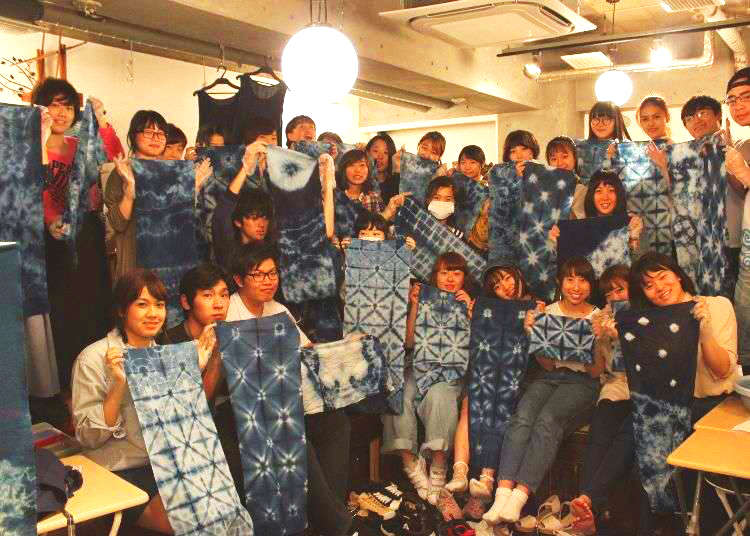
Did you know that blue is one of Japan’s most loved and significant colors? Specifically, the deep blue of indigo has been a popular kimono color since ancient times, and it is also the color of the official logo for the Tokyo Olympic and Paralympic Games 2020. Japan has its own dyeing technique called “aizome,” literally indigo dyeing, utilizing a plant called “tade.” Aizome has been introduced to Japan in Nara period (710 – 794), and it is said that depending on different factors, such as mixture and time, this Japanese indigo can be separated into a total of 48 different shades!
A shop in Asakusa called Wanariya lets you experience this traditional technique of dyeing for yourself. T-shirts, tote bags, all kinds of different items and garments can be dyed in this mystical blue, the color of Old Japan. LIVE JAPAN joined 28 Japanese and international students on their quest to traditionally dye their own hand towels!
A Fermented Plant as the Main Ingredient for Japanese Indigo Blue
“It’s unbelievable that there’s no dyeing shop in Asakusa” was the thought that led to Mr. Kikuchi opening Wanariya, having learned aizome from his grandfather and continuing the family tradition in the third generation. Operating under the concept of being a gate to Japanese culture, the aizome store welcomes shoppers and visitors from both Japan and abroad with open arms.

The aizome experience begins with a lecture on the history of Japanese indigo dyeing. The plant called tade (smartweed in English) is fermented and becomes the base ingredient for a dye called sukumo. This indigo dye is said to have many properties: it acts as an insect repellant, shields against sunburn, and rarely allergy-causing. The college students all listen attentively.
Deciding the Design via Three Different Dyeing Techniques
Next is an explanation of the different methods of aizome dyeing. Stripes, the traditional pattern called “asanoha,” and Wanariya’s own “shibori”, or tie-dyeing make the three different aizome techniques. You can choose between these patterns or make your very own, original one with wrapping and rubber-bands.
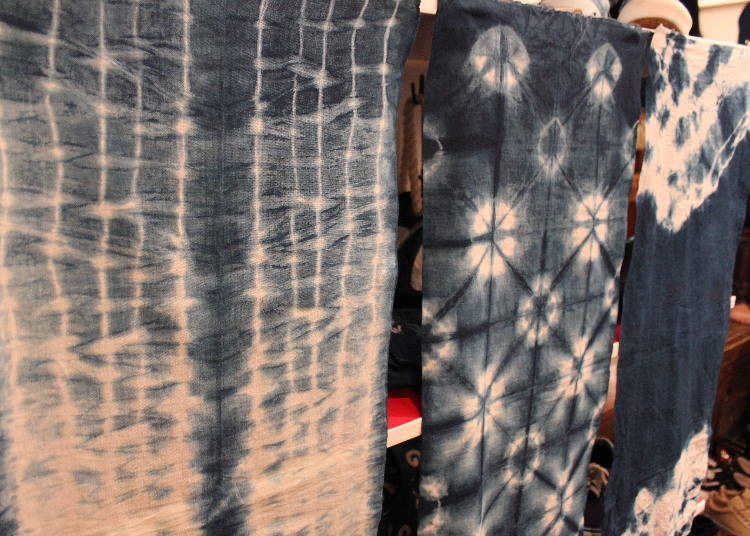
“I want it to look cute, but how do I do that...”
Even with the model cloth in front of the students, they’re having trouble imagining how an intricate pattern such as this will come to be with only wrapping and rubber bands. Some choose to methodically wrap the fabric, while others think carefully about the design and apply the tie-dyeing method accordingly. Some even choose to be surprised by the outcome and utilize rubber bands and ties wherever they seem to fit – in any case, everyone is working excitedly on their very own hand-dyed towel.


Aizome 101 – Soaking the Fabric in Dye Three Times
Once the future pattern is decided, the real aizome dyeing starts. A large barrel contains the natural indigo dye.
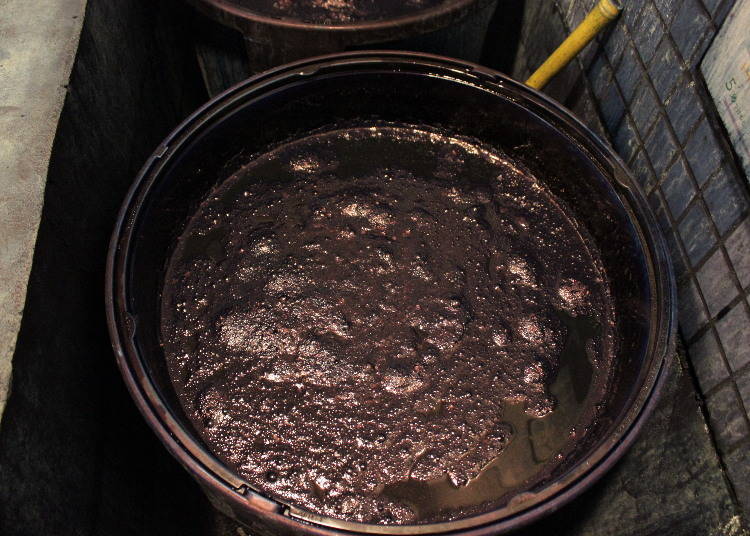
“The dye that we’re using today is called shibu-ai, one of the noblest colors among the 48 shades of Japanese indigo. Smell it – a lot of people say it has a bit of a fishy smell but it seems to work great with people who suffer from hay fever.”
The students give the big pot of dye a whiff as the store manager, Mr. Kikuchi, explains more about the indigo color.
“The bacteria is still very much alive in this pot and react with the dye. The substance that is floating on the top is called ‘indigo flower’ and the result of this reaction.
The cloth is dipped right in this “indigo flower,” submerged for a while, then raised to air again before soaking the dye once more. The time of this soaking is said to determine the condition of the dyeing.
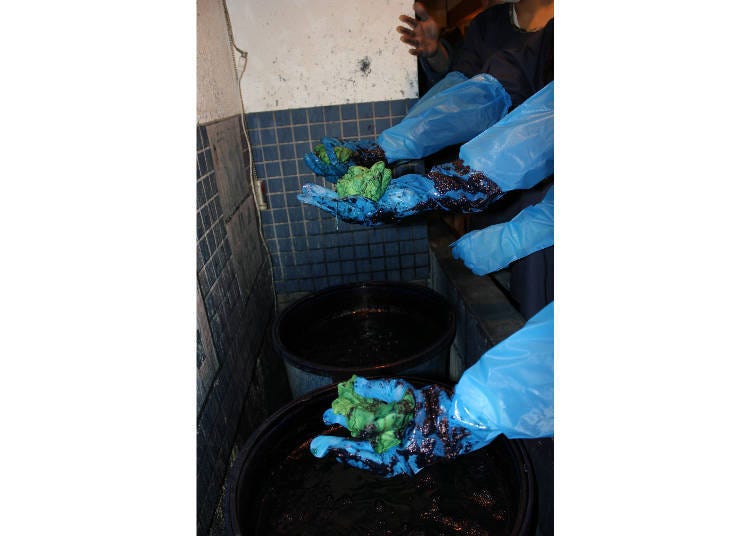
Especially the second soaking is important because it will convey the real feeling of having dyed the cloth. After submerging it one more time, the towel will start to look almost black.
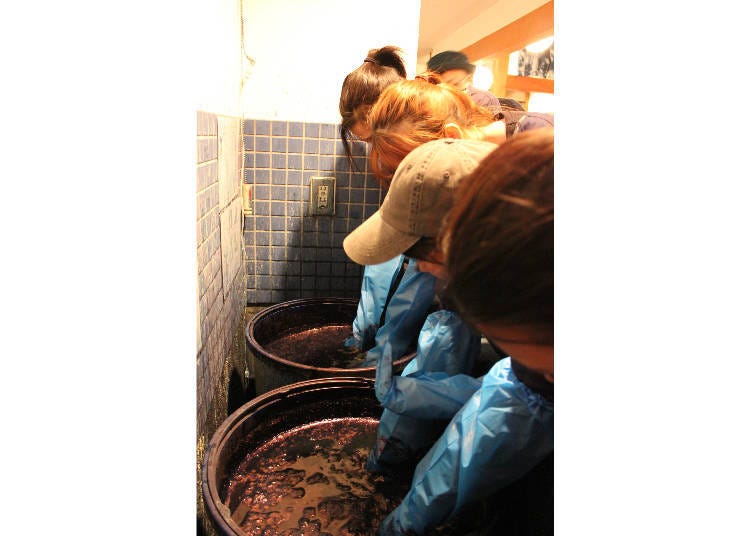

After soaking the cloth three times in total, it is cleaned in a washing machine to wash out excess indigo dye and finally dried. The aizome process is complete, so let’s remove any rubber bands and take a look at the results!
The Aizome Results: Surprisingly Beautiful
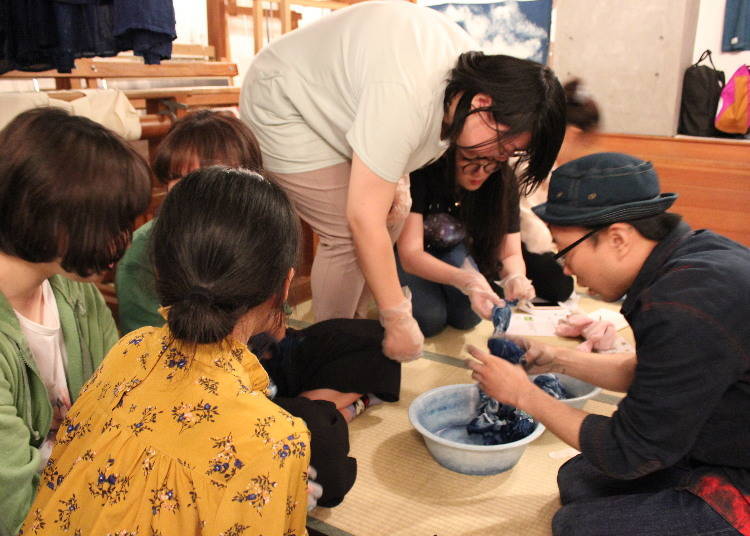
“Oh, wow!”
“It really turned out to be pretty!”
Cheers of joy can be heard here and there as the students look at their hand-dyed aizome towels. Even though everyone dyed their cloth together, some are a deep and rich blue, while others have a much lighter shade. Some look like cloudy skies, while others resemble intricate floral patterns. Everyone seems very pleased and surprised by their unique design, showing each other their different towels.
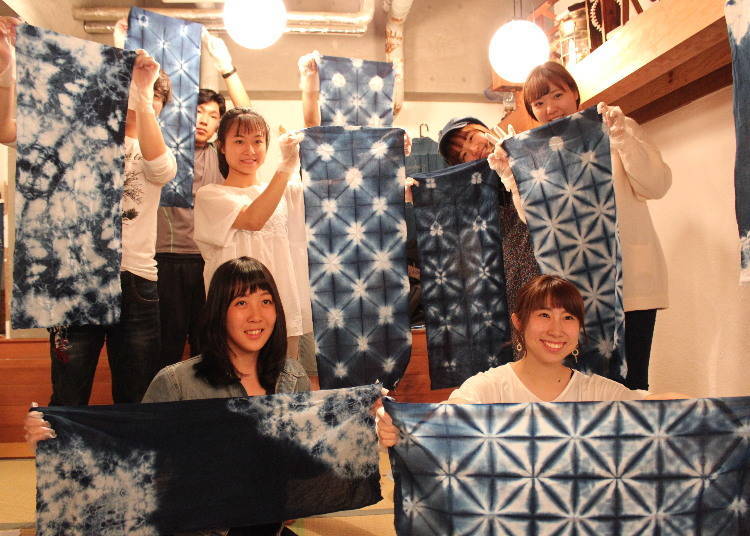
“I thought that aizome dyeing only results in an indigo color, but I never imagined that it has 48 unique shades!” (Nationality: Japan)
“Dyeing towels might seem boring at first, but I was really surprised how much you can do with color depth and design! It’s a traditional color in modern times, and I think I made a really cool thing.” (Nationality: China)
“I chose the Wanariya shibori design, and the contrast of dark blue and white really came out nicely. There’s someone else who did the Wanariya shibori design, and their towel looks completely different from mine! It’s really interesting that everyone’s came out so unique.” (Nationality: Japan)
“When we started the aizome, the towel was a shallow yellow. But after oxidizing it, the color got darker and richer. The change in color throughout the process is really beautiful.” (Nationality: Japan)
“The one thing that impressed me the most is the hands of the artisans. Their palms and fingernails are dyed blue. If you ask them to take a picture, they show their hands really proudly. I looked at these hands and could actually see the passion they have for their craft. I don’t think that there are many people who want to do this kind of job in a modern day and age, but it’s a tradition with a long history in Japan and I do believe it should continue to live on.” (Nationality: China)
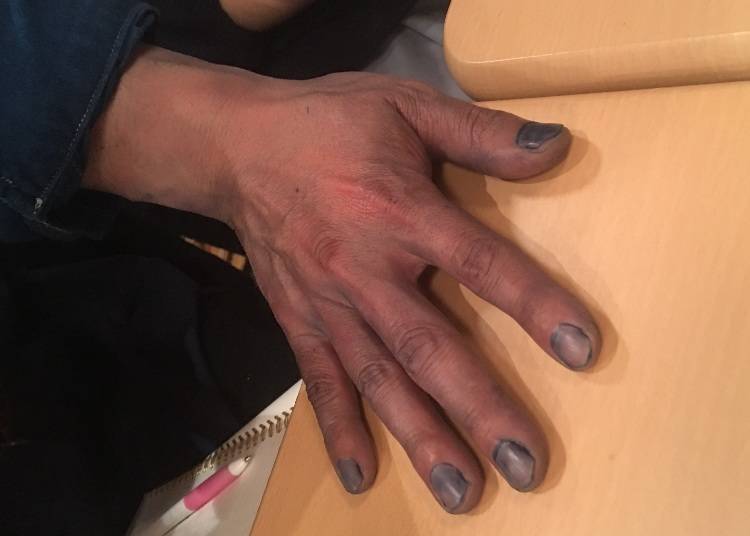
“It was really interesting to make a pattern by deciding places that the air and dye can and cannot reach. I did realize that it requires great skill as a craftsman to master this aizome technique and create products that the customer is happy with.” (Nationality: Japan)
“I usually don’t have much interest in tradition and such technologies, but I took away one important thing from this aizome experience: ‘a heart that is not afraid of failure.’ There really is no such thing as a failure when it comes to aizome. At first, I thought: ‘What should I do if I screw it up?’ But I was encouraged: ‘If the result is different from what you wanted it to be, that’s because of the living things in the dye. They’re alive and have their own wish to dye, just like us.’ The design that I ended up with was more beautiful than what I imagined.
I could feel the knowledge and wisdom of the Wanariya artisans and their predecessors, and their wish to spread Japanese indigo to the world. They blend tradition and fashion and craft their products to suit people’s tastes. Even if the times change, this craftsman spirit should be carried on.” (Nationality: China)
“It’s a fun experience and you really can’t tell what the result is going to be. But you’ll be surprised and happy in any case!” (Nationality: Malaysia)
“I got to experience aizome dyeing under the guidance of a real artisan and can take my hand-dyed towel home. Also, I learned more about Japan’s traditional culture and started to really love it. It was a wonderful experience for me.” (Nationality: Vietnam)
“I believe that mistakes are a common thing when making something, but even what I perceive as a failure will turn out to be a beautiful design in aizome dyeing. Making such an experience in a place like Asakusa adds to the atmosphere, and I think that Japanese traditional culture can be felt even better here.” (Nationality: Japan)
While everyone was excited and had fun throughout the entire experience, the traditional technique and art of craftsmanship also seem to have left quite an impression on the students. If you’re looking to not only get an authentic taste of traditional Japanese craftsmanship yourself but are also on the lookout for a true one-of-a-kind work of art, look no further than Wanariya and its aizome dyeing.
-
Wanariya和なり屋
- Address 1-8-10 Senzoku, Taito-ku, Tokyo-to 111-0031
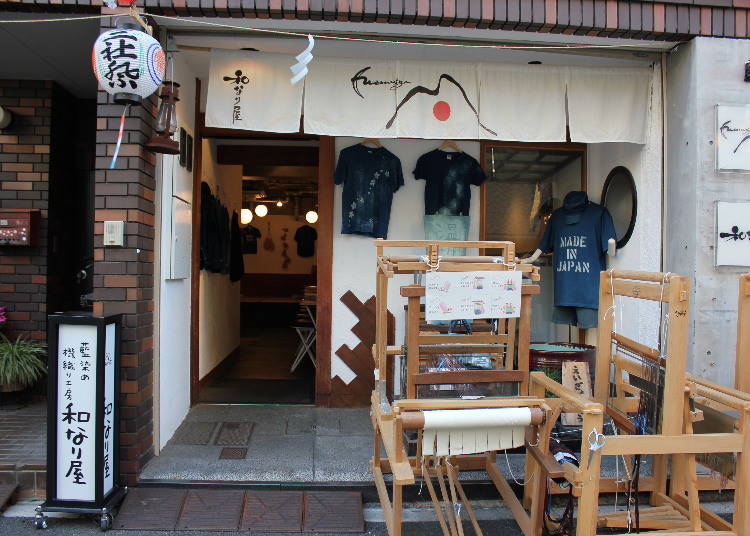
Hours: 10 a.m. – 7:00 p.m.
Holidays: irregular
Aizome Experience (available in English)
・Hand towel (35cm × 90cm): 1,920 yen (tax included); 45 minutes (same price as handkerchief dyeing)
・Stole (30cm × 135cm): 4,280 yen (tax included)
・Eco tote bag (35cm × 35cm × 10cm: 3,600 yen (tax included)
・T-Shirt (S ~ XL): 3,600 yen (tax included)
Reservation & Inquiry:
TEL / FAX: 03-5603-9169
Email:mail@wanariya.jp
Homepage: http://wanariya.jp/
-
 LIVE JAPAN is certified by the beyond2020 program.
LIVE JAPAN is certified by the beyond2020 program.
- Area
- Category
*Prices and options mentioned are subject to change.
*Unless stated otherwise, all prices include tax.
Popular Tours & Activitiess
-

2025 Autumn Colors Report: Kurobe Gorge Nearing Peak
by: Timothy Sullivan
-

2025 Japan Autumn Color Report: Tokyo's Ginkgo Trees Starting to Glow
by: Timothy Sullivan
-

Don't Miss Out! The One Thing You Must Do Before Shopping at Mitsui Shopping Park LaLaport: Get Your Max 10% OFF Coupon Book
-

Get Ready to Catch 'Em All! First Ever Permanent Outdoor Pokémon Park Opening Near Tokyo!
-
Ad

Walk in the Footsteps of Believers: A 4-Day Pilgrimage Across Goto Islands, Nagasaki Prefecture
by: Yohei Kato
-

Enjoy Japan's Gorgeous Winter Lights! Ride the Romancecar to Shonan no Hoseki Illumination
by: Guest Contributor
Inspiration for Accommodations
-

Enjoy Mt. Fuji from the Comfort of Your Room! Recommended Ryokan with Mt. Fuji View
-

Stay Near the Cherry Blossoms! Hotels for Cherry Blossom Viewing in Tokyo
-

Family-Friendly Hotels with Free Shuttle to Disneyland: Convenient Access for a Magical Stay
-

Top Ranked Hakone Hotels with Mt. Fuji View: Enjoy Stunning Scenery from Your Private Space
-

Convenient Tokyo Hotels with Airport Shuttle: Ideal for Families and Heavy Luggage
-

Stunning Tokyo Tower View Hotels: Enjoy Spectacular Scenery from Your Private Space
-

Convenient Asakusa Hotels with Kitchens: Ideal for Extended Family Visits
-

Experience Luxury: Hakone's 10 Best Five-Star Accommodations
-

Enjoy Mt. Fuji Autumn Leaves! Top Hotels Near the Popular Autumn Leaves Corridor
-

Experience Hakone Fall Foliage from Your Room with Stunning Views
-

Tokyo Station: Then and Now
-

Tokyo Daikanyama: Exotic Atmosphere, Beautiful Streets, and 7 Top Shops
-

Exploring Tokyo: 4 Must-Visit Spots around Tokyo Station
-

Atami 1-Day Itinerary: Exploring Japan's Castle & Hot Springs Resort Town Near Tokyo!
-

Kichijoji – Explore Tokyo’s Top-Rated Stylish Suburb in Half a Day!
-

15 Mistakes Tourists Make When Visiting Tokyo for the First Time
- #best ramen tokyo
- #what to buy in ameyoko
- #what to bring to japan
- #new years in tokyo
- #best izakaya shinjuku
- #things to do tokyo
- #japanese nail trends
- #what to do in odaiba
- #onsen tattoo friendly tokyo
- #daiso
- #best sushi ginza
- #japanese convenience store snacks
- #best yakiniku shibuya
- #japanese fashion culture
- #best japanese soft drinks


















